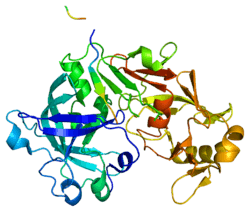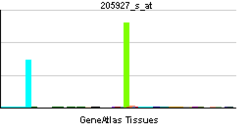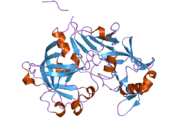Cathepsin E
Cathepsin E is a protein that in humans is encoded by the CTSE gene.[1][2][3]
The protein encoded by this gene is a gastric aspartyl protease that functions as a disulfide-linked homodimer. This protease, which is a member of the peptidase A1 family, has a specificity similar to that of pepsin A and cathepsin D. It is an intracellular proteinase that does not appear to be involved in the digestion of dietary protein and is found in highest concentration in the surface of epithelial mucus-producing cells of the stomach. It is the first aspartic proteinase expressed in the fetal stomach and is found in more than half of gastric cancers. It appears, therefore, to be an oncofetal antigen. Transcript variants utilizing alternative polyadenylation signals and two transcript variants encoding different isoforms exist for this gene.[3]
References
- ↑ Couvreur JM, Azuma T, Miller DA, Rocchi M, Mohandas TK, Boudi FA, Taggart RT (Aug 1990). "Assignment of cathepsin E (CTSE) to human chromosome region 1q31 by in situ hybridization and analysis of somatic cell hybrids". Cytogenet Cell Genet 53 (2-3): 137–9. doi:10.1159/000132914. PMID 2369841.
- ↑ Azuma T, Pals G, Mohandas TK, Couvreur JM, Taggart RT (Oct 1989). "Human gastric cathepsin E. Predicted sequence, localization to chromosome 1, and sequence homology with other aspartic proteinases". J Biol Chem 264 (28): 16748–53. PMID 2674141.
- ↑ 3.0 3.1 "Entrez Gene: CTSE cathepsin E".
Further reading
- Tsukuba T, Yamamoto K (2003). "[Atopic dermatitis and cathepsin E]". Nippon Yakurigaku Zasshi 122 (1): 15–20. doi:10.1254/fpj.122.15. PMID 12843568.
- Flynn TJ, Deshmukh DS, Pieringer RA (1977). "Effects of altered thyroid function on galactosyl diacylglycerol metabolism in myelinating rat brain.". J. Biol. Chem. 252 (16): 5864–70. PMID 195962.
- Azuma T, Liu WG, Vander Laan DJ et al. (1992). "Human gastric cathepsin E gene. Multiple transcripts result from alternative polyadenylation of the primary transcripts of a single gene locus at 1q31-q32.". J. Biol. Chem. 267 (3): 1609–14. PMID 1370478.
- Saku T, Sakai H, Shibata Y et al. (1992). "An immunocytochemical study on distinct intracellular localization of cathepsin E and cathepsin D in human gastric cells and various rat cells.". J. Biochem. 110 (6): 956–64. PMID 1794985.
- Athauda SB, Takahashi T, Inoue H et al. (1992). "Proteolytic activity and cleavage specificity of cathepsin E at the physiological pH as examined towards the B chain of oxidized insulin.". FEBS Lett. 292 (1-2): 53–6. doi:10.1016/0014-5793(91)80832-N. PMID 1959628.
- Lees WE, Kalinka S, Meech J et al. (1990). "Generation of human endothelin by cathepsin E.". FEBS Lett. 273 (1-2): 99–102. doi:10.1016/0014-5793(90)81060-2. PMID 2226872.
- Athauda SB, Matsuzaki O, Kageyama T, Takahashi K (1990). "Structural evidence for two isozymic forms and the carbohydrate attachment site of human gastric cathepsin E.". Biochem. Biophys. Res. Commun. 168 (2): 878–85. doi:10.1016/0006-291X(90)92403-M. PMID 2334440.
- Fowler SD, Kay J, Dunn BM, Tatnell PJ (1995). "Monomeric human cathepsin E.". FEBS Lett. 366 (1): 72–4. doi:10.1016/0014-5793(95)00501-Y. PMID 7789521.
- Finley EM, Kornfeld S (1995). "Subcellular localization and targeting of cathepsin E.". J. Biol. Chem. 269 (49): 31259–66. PMID 7983070.
- Takeda-Ezaki M, Yamamoto K (1993). "Isolation and biochemical characterization of procathepsin E from human erythrocyte membranes.". Arch. Biochem. Biophys. 304 (2): 352–8. doi:10.1006/abbi.1993.1361. PMID 8346912.
- Schulz TF, Reeves JD, Hoad JG et al. (1993). "Effect of mutations in the V3 loop of HIV-1 gp120 on infectivity and susceptibility to proteolytic cleavage.". AIDS Res. Hum. Retroviruses 9 (2): 159–66. doi:10.1089/aid.1993.9.159. PMID 8457383.
- Finzi G, Cornaggia M, Capella C et al. (1993). "Cathepsin E in follicle associated epithelium of intestine and tonsils: localization to M cells and possible role in antigen processing.". Histochemistry 99 (3): 201–11. doi:10.1007/BF00269138. PMID 8491674.
- Azuma T, Hirai M, Ito S et al. (1996). "Expression of cathepsin E in pancreas: a possible tumor marker for pancreas, a preliminary report.". Int. J. Cancer 67 (4): 492–7. doi:10.1002/(SICI)1097-0215(19960807)67:4<492::AID-IJC5>3.0.CO;2-N. PMID 8759606.
- Sealy L, Mota F, Rayment N et al. (1996). "Regulation of cathepsin E expression during human B cell differentiation in vitro.". Eur. J. Immunol. 26 (8): 1838–43. doi:10.1002/eji.1830260826. PMID 8765029.
- Bernstein HG, Reichenbach A, Wiederanders B (1998). "Cathepsin E immunoreactivity in human ocular tissues: influence of aging and pathological states.". Neurosci. Lett. 240 (3): 135–8. doi:10.1016/S0304-3940(97)00946-4. PMID 9502222.
- Cook M, Caswell RC, Richards RJ et al. (2001). "Regulation of human and mouse procathepsin E gene expression.". Eur. J. Biochem. 268 (9): 2658–68. doi:10.1046/j.1432-1327.2001.02159.x. PMID 11322887.
- Suzuki Y, Tsunoda T, Sese J et al. (2001). "Identification and characterization of the potential promoter regions of 1031 kinds of human genes.". Genome Res. 11 (5): 677–84. doi:10.1101/gr.164001. PMC 311086. PMID 11337467.
- Strausberg RL, Feingold EA, Grouse LH et al. (2003). "Generation and initial analysis of more than 15,000 full-length human and mouse cDNA sequences.". Proc. Natl. Acad. Sci. U.S.A. 99 (26): 16899–903. doi:10.1073/pnas.242603899. PMC 139241. PMID 12477932.
External links
- The MEROPS online database for peptidases and their inhibitors: A01.010
PDB gallery |
|---|
| | 1tzs: Crystal Structure of an activation intermediate of Cathepsin E |
|
|
|
|
|---|
| | Vertebrate | |
|---|
| | Pathogenic | |
|---|
| | Plant | |
|---|
| | Cathepsin | |
|---|
|
- Biochemistry overview
- Enzymes overview
- By EC number: 1.1
- 2
- 3
- 4
- 5
- 6
- 7
- 8
- 10
- 11
- 13
- 14
- 15-18
- 2.1
- 3.1
- 4.1
- 5.1
- 6.1-3
|
|
|
|


